Imola’s Hidden Past
How it All Began
The Autodromo Internazionale Enzo e Dino Ferrari, more commonly known as Imola, first opened its gates in 1953. Originally, the track didn’t host Formula 1 races. It wasn’t until the 1980s that it became a regular venue for the F1 calendar, playing host to the San Marino Grand Prix.
Challenges and Triumphs
Navigating Imola has never been a walk in the park. With its chicanes, fast corners, and elevation changes, it’s a driver’s dream and nightmare combined. The track witnessed Ayrton Senna’s last race in 1994, making it a bittersweet spot in F1 history.
Zandvoort’s Sands of Time
The Birth of Dutch Racing
Situated amidst the dunes of the North Sea coast, Circuit Zandvoort in the Netherlands originally opened in 1948. It was a track created from the remnants of a post-World War II world, using roads initially built by the German military.
Key Moments in Racing History
The Dutch Grand Prix, hosted at Zandvoort, witnessed the rise of many iconic racers. Names like Niki Lauda, Alain Prost, and James Hunt have all raced along its winding paths, adding rich chapters to the track’s lore.
Portugal’s Algarve Rollercoaster
Portimão’s Birth and Ascent
The Algarve International Circuit, often referred to as Portimão, is one of the younger tracks in Europe, having been inaugurated in 2008. Yet, its swift, undulating layout quickly caught the attention of drivers and fans alike.
Facts about Portimão
- Holds a record for hosting multiple motorsport events in its inaugural year.
- Its unique elevation changes have earned it the nickname “The Rollercoaster.”
- Became an unexpected addition to the 2020 F1 calendar due to the pandemic’s disruption.
- Lewis Hamilton secured his 92nd win here, surpassing Michael Schumacher’s record.
Remembering France’s Magny-Cours
From Humble Beginnings
Situated in the heart of France, Circuit de Nevers Magny-Cours started as a basic track in the 1960s. It evolved over the decades to eventually host the French Grand Prix, providing racers with a technically demanding layout.
Memorable F1 Moments
Magny-Cours has seen spectacular overtakes, strategic masterclasses, and intense rivalries unfold. The track was the theatre of the 2008 title-deciding race, which saw Felipe Massa and Lewis Hamilton battle it out till the very end.
The Charms of Turkey’s Istanbul Park
The Creation of a Modern Classic
Istanbul Park, with its challenging Turn 8 and counter-clockwise rotation, became an instant hit when it was introduced in 2005. The track’s diverse range of corners made it a favorite among drivers, drawing comparisons to great circuits like Spa-Francorchamps.
Unforgettable Racing Episodes
From Jenson Button’s maiden win in 2009 to Sebastian Vettel’s spin in 2020, Istanbul Park has never failed to deliver thrills and spills. The blend of speed and strategy ensures that every race here remains etched in F1 aficionados’ memories.
Spain’s Enigmatic Jerez Circuit
The Andalusian Gem
Nestled in the heart of Spain’s sherry-producing region, the Circuito de Jerez is often overshadowed by its flashier compatriots. But this track, inaugurated in 1985, has its own unique charm. The combination of tight hairpins, fast straights, and challenging chicanes makes it a formidable ground for racing.
The Epic Finales
Jerez has been the backdrop for some of F1’s most climactic season finales. Who could forget the 1997 European Grand Prix? This showdown between Jacques Villeneuve and Michael Schumacher remains one of the sport’s most debated incidents.
The Twists of Hungary’s Hungaroring
From Soviet Bloc to F1 Hotspot
Established in 1986, the Hungaroring was the first circuit in the Eastern Bloc to host a Formula 1 race. Located just outside Budapest, this track has always been a challenge due to its dusty surface and lack of overtaking spots.
Underdogs and Unexpected Wins
Hungaroring is known for throwing curveballs. Damon Hill nearly clinched a win in an Arrows car in 1997, and Jenson Button claimed his first-ever F1 victory amidst the rain in 2006. Such surprises make the Hungarian GP a must-watch event year after year.
Conclusion
Europe’s lesser-known tracks are more than just asphalt and barriers. They carry tales of glory, heartbreak, innovation, and evolution. While they may not always take centre stage in the F1 calendar, their histories are deeply intertwined with the very fabric of motorsport.





